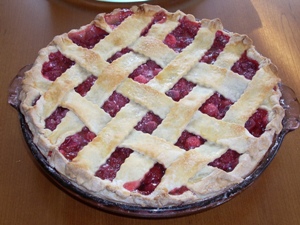 Guest post by Marijean Jaggers, vice president, Standing Partnership.
Guest post by Marijean Jaggers, vice president, Standing Partnership.
It may sound funny, but I have a true story of how pie and social media helped build community.
I decided a couple of years ago I would master the art of pie making and therefore become the relative and friend everyone knows for making really fine pies.
When I’m not baking, I work in public relations and, more broadly, reputation management. Dealing with intangibles all day made me crave hands-on activities. There’s nothing quite as satisfying as rolling out a crust at the end of a long day, filling it with something sweet, and presenting it to my family or friends for an all-too-brief period of consumption.
In a strange convergence of personal interest and professional passion, I helped develop a local pie festival that began with a challenge on Twitter. In my town, pie became an excellent vehicle for creating community. It was also instrumental in demonstrating social media as a communications and community-building tool.
 I’ve shared and demonstrated my passion for pie on my personal blog, on Twitter, and on Facebook. I often share pie with people in my social network. I’ve given pies as rewards to Standing Partnership colleagues for a job well done and to people leaving comments on my blog (interestingly attracting as many business prospects as friends and pie-enthusiasts). Trust me: It’s difficult to refuse someone bearing fruit baked into a tender, flaky crust.
I’ve shared and demonstrated my passion for pie on my personal blog, on Twitter, and on Facebook. I often share pie with people in my social network. I’ve given pies as rewards to Standing Partnership colleagues for a job well done and to people leaving comments on my blog (interestingly attracting as many business prospects as friends and pie-enthusiasts). Trust me: It’s difficult to refuse someone bearing fruit baked into a tender, flaky crust.
What I’ve learned is this: If you’re passionate about something, share it wide and far. The community will create itself around what you have to share, and you’ll end up developing deeper, richer relationships with the people who comprise your social network.
So here are five ways pie and social media helped build community:
- It was easy to quickly share information about a competitive pie event via Twitter; it helped that the main people involved already had strong Twitter and blog followers, but the promise of an in-person event with a payoff (pie!) helped the community grow quickly.
- The promise of something free. I’m sure the promise of a taste of award-winning pie was instrumental in getting many people in the community to opt into the event and sustained interest for future events, and that’s OK.
- The community was, from the outset, very inclusionary. The first event brought strangers offline and in person, solidifying relationships that had previously been fleeting. The event was open to people of all ages and attracted members of the community from all socio-economic levels.
- It helped local business people and members of the media understand Twitter and how quickly social media can mobilize people when there’s a common goal and interest.
- It created a collaborative community that realized the potential of the gathering. That community vowed to continue with what began and evolved into an event benefiting a local charity and attracting fans and followers near and far.
As a vice president and manager of St. Louis-based reputation management firm Standing Partnership’s satellite office in Charlottesville, Va., Marijean Jaggers is a social media specialist providing education and counsel to clients in several industries in the U.S. and Europe.